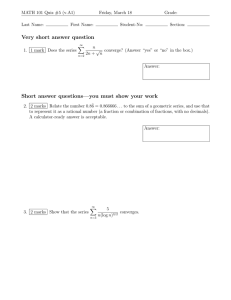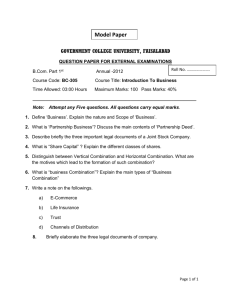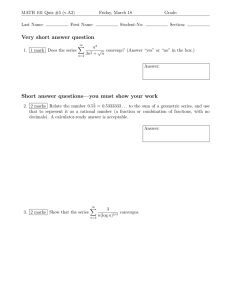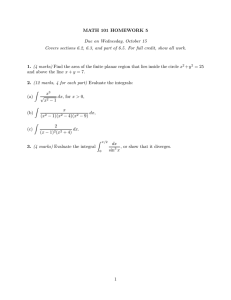0680 ENVIRONMENTAL MANAGEMENT MARK SCHEME for the May/June 2011 question paper
advertisement
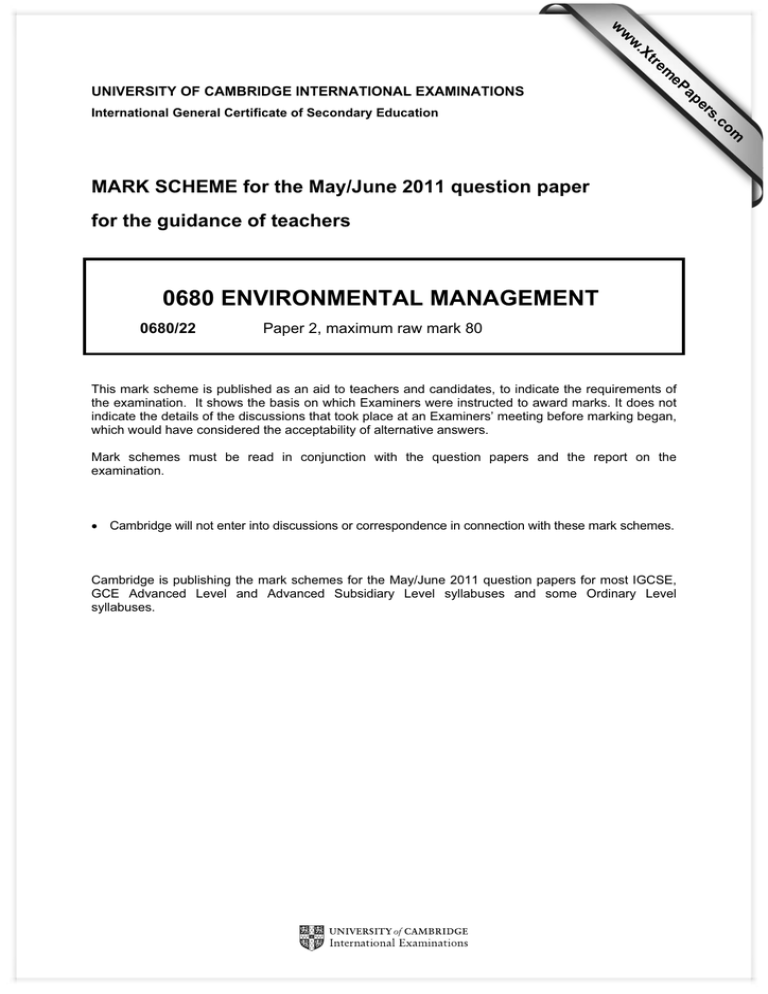
w w ap eP m e tr .X w UNIVERSITY OF CAMBRIDGE INTERNATIONAL EXAMINATIONS for the guidance of teachers 0680 ENVIRONMENTAL MANAGEMENT 0680/22 Paper 2, maximum raw mark 80 This mark scheme is published as an aid to teachers and candidates, to indicate the requirements of the examination. It shows the basis on which Examiners were instructed to award marks. It does not indicate the details of the discussions that took place at an Examiners’ meeting before marking began, which would have considered the acceptability of alternative answers. Mark schemes must be read in conjunction with the question papers and the report on the examination. • Cambridge will not enter into discussions or correspondence in connection with these mark schemes. Cambridge is publishing the mark schemes for the May/June 2011 question papers for most IGCSE, GCE Advanced Level and Advanced Subsidiary Level syllabuses and some Ordinary Level syllabuses. om .c MARK SCHEME for the May/June 2011 question paper s er International General Certificate of Secondary Education Page 2 1 Mark Scheme: Teachers’ version IGCSE – May/June 2011 Syllabus 0680 Paper 22 (a) Atmosphere – sunlight (solar power), precipitation (rainfall), oxygen, wind energy On land surface – soil, plants (vegetation), wild animals (fauna) Oceans – fish, salt, other minerals (notably oil & gas) These are the likely examples; many others are acceptable provided that they are different e.g. from plants, an example of a food and raw material (rice and rubber) from animals, an example of a food producing and draught animal (chicken and camel) from oceans such as tuna and sponges / pearls Assess on the basis of being sufficiently different when individuals rather than groups are named by candidate. Basically half marks for each answer, but the final sub-section mark must always be a whole mark. This might allow breathing space for the assessment of less obvious answers. In general, 1 or 2 valid answers = 1 mark 3, 4 or 5 valid answers = 2 marks all 6 valid answers = 3 marks [3] (b) (i) Overwhelmingly concentrated in three continents in the developed world / temperate lands, Europe, North America and Australasia (Oceania), the highest of all above 6 per person are concentrated in North America and Australasia, many countries in north and west Europe in the 4 to 6 per person range, elsewhere above average are well scattered in Africa, large block in east and south of South America, but with some Middle Eastern countries showing up as well above average, references to specific examples which contrast with neighbours e.g. UAE, Japan. These are some of many possibilities. For guidance only but most likely – minimum 3 marks, maximum 4 marks for this part. (ii) Countries overwhelmingly concentrated in two of the three developing world continents, in Africa and Asia (and to a lesser extent Central & South America), large continuous blocks of countries in south/east Asia and central Africa below average. These are only the most obvious differences. One mark reserved for a clearly identified difference. For guidance only, but most likely minimum 1 mark, maximum 2 marks for this part. Mark the worth of the answer overall since the two parts are closely related / not mutually distinctive. [5] (iii) Countries need to be correctly located and named for the marks. 2 @ 1 mark © University of Cambridge International Examinations 2011 [2] Page 3 Mark Scheme: Teachers’ version IGCSE – May/June 2011 Syllabus 0680 Paper 22 (iv) Reasons for differences in ecological footprint levels include: – wealth and level of economic development; why these are associated with higher levels of resource use per head for industry, transport, domestic consumption etc. These are the reasons about which candidates are likely be able to write the most and explain most successfully. – great size of the home resource base; around the oil rich Gulf countries (e.g. UAE, Kuwait on world map); Australia and Canada are great mineral exporting countries. – countries with some difficult environmental conditions where high / comfortable living standards are costly to achieve such as Middle East and Australia (desert heat and water shortages), Canada and Norway winter cold and daylight shortage – reverse for countries with small footprints; the majority are poor subsistence / rural based economies, too poor to afford to import resources needed for development. The emphasis here is on giving reasons and explaining rather than giving a variety of different reasons. Mark the worth of the answer on this basis. Some reasons given, but simple and without development. Statements about the country with the low footprint may merely be the reverse of those for the one with the high footprint or differences may not be made clear = 1 or 2 marks Fuller reasons which make clear the differences between the two countries in terms of ecological footprint. For all four marks something specifically related to at least one of the two identified countries is needed = 3 or 4 marks. [4] (v) Unsustainable because there are going to be fewer and fewer resources for future generations to use (i.e. the prime need for a sustainable resource), will get worse year by year as the size of the resource gap will widen / increase, examples of unsustainable natural resources are fossil fuels and most other minerals, further explanation about why they are non-sustainable in relation to their formation or their value to humans or scale with which they are used or mineral 'life expectancies', other normally sustainable natural resources remain sustainable only for as long as they are used within the time needed for replenishment e.g. references to fish stocks etc. Basic answer about non-sustainability = 1 mark (possibly worth 2 marks) Explanation with reference to examples of natural resources = 2 marks 3 @ 1 mark (c) (i) 10 times [3] [1] (ii) All correct plots = 2 marks Solid line used to link the points to 2000 and a broken line or line of different colour for 2000–2050 = 2 marks Fall-back positions; 3 plots correct = 1 mark Continuous line of the same type connecting all plots = 1 mark [3] © University of Cambridge International Examinations 2011 Page 4 Mark Scheme: Teachers’ version IGCSE – May/June 2011 Syllabus 0680 Paper 22 (iii) The fast growth trend from 1950 onwards is clear on the graph, expected part of line remains as steep / population growth similarly rapid to 2050, therefore even more people for the Earth's finite natural resource base. Graph evidence used correctly and explained / understood in terms of Earth's natural resources = 2 marks Part answer = 1 mark [2] (d) (i) 123 million [1] (ii) 21 per 1000 [1] (iii) Predominantly a young / youthful population, almost half of them yet to reach child bearing / producing ages, who will marry and have their own families continuing population growth. Understood and well stated = 2 marks Some recognition but not fully described = 1 mark [2] (iv) Factors which help to explain low take-up of family planning in countries: – poverty; national costs of implementation of programmes and policies – political; low priority, resources spent in other ways, weak government – religion; not normally part of state policy in Muslim and Catholic countries – attitude; socially, culturally and economically unacceptable – infrastructure; problems of implementation in remote regions Explanatory points can be made following on from the factors suggested above. One factor only; range of factors with little explanation; focus on individuals rather than countries = 1 or 2 mark answers References included to at least two factors that are clearly different; attempts to explain the significance of factors; focus is on countries = 3 or 4 mark answers [4] (e) (i) Possible advantages of conservation of forests to be added to the spider diagram: – carbon store / plants take carbon dioxide out of atmosphere – potential sources of new medicines / crops from plants – home, food and materials source for indigenous tribes / people – products useful to outsiders such as Brazil nuts and natural rubber – oxygen supply to the atmosphere during process of photosynthesis – growth of tourism as an economic activity in conserved forests – used for selective logging (i.e. an example of something specific with forests conserved) Three advantages such as these. 3 @ 1 mark © University of Cambridge International Examinations 2011 [3] Page 5 Mark Scheme: Teachers’ version IGCSE – May/June 2011 Syllabus 0680 Paper 22 (ii) Has created unique species and living environments in harmony with a wide variety of natural environments, biodiversity is a genetic resource for humans, wild plants and animals are the source of all cultivated crops and domesticated animals used for human food supply, the wider the genetic pool the more chance of finding new strains of crops for particular purposes / to suit particular growing conditions, many present day / likely future drugs are derived from natural plants, specific examples to illustrate any of these. 3 explanatory points made along these lines. 3 @ 1 mark [3] (iii) Essentially because the short-term financial gains are so great, money from logging, extracting minerals and use of cleared land for farming, for economic development by governments in developing countries, landless people able to have their own land to farm once forests are cleared, population pressure leading to great use of forest resources for fuel etc., all the advantages are long-term and income from them is less obvious, benefits of conservation are likely to be as great / greater for people living in other countries / developed world which have consumed own forest resources. Three points made along these lines which directly answer the question. 3 @ 1 mark [3] [Total: 40] 2 (a) (i) Limestone Oil (petroleum) Iron ore Uranium All 4 correct = 2 marks 2 or 3 correct = 1 mark [2] (ii) Bauxite – aluminium Coal – electricity, heating / smelting Diamonds – jewellery (or individual items), industrial cutting Lead – batteries, cables, roofing Phosphates – fertilisers Also allow the minerals which formed the answers in part (i) provided they were not used by the candidate in (i) and they give another use which is correct. Only one use needed for the mark; answers which list more than one use are credited as well provided that all uses are valid. 2 @ 1 mark © University of Cambridge International Examinations 2011 [2] Page 6 Mark Scheme: Teachers’ version IGCSE – May/June 2011 Syllabus 0680 Paper 22 (b) (i) Opencast mining (or directly equivalent such as open pit mining). [1] (ii) Vertical shaft cut from the surface down to rock layer B, horizontal tunnels made as cutters work along to remove mineral, mineral (and waste) lifted up to the surface through the shaft, further detail of mining processes such as mechanical cutters in modern mines. Points made along these lines. 3 @ 1 mark [3] (iii) Easier and cheaper to build mines on the surface, some description of techniques such as scraping off surface vegetation and soil and then using giant cranes and diggers, can target directly places where the mineral is most available, technically more difficult to build and operate an underground mine, layer B is quite deep at 200 metres which makes it more difficult, much time taken up each day by miners getting to and back from work place. Points made along these lines which show understanding. Credit quality of explanation as well. 3 @ 1 mark [3] (iv) The answer A can be justified by extent of the damage on the surface from four mines instead of just one underground mine; also choice can be explained with reference to the techniques used, the scale of the operations and to the direct destruction of surface vegetation and wildlife habitats. Whereas waste heaps from mine B will be piled up in one place and the rest of area might be untouched. An answer B is harder to support; deep mining in general is more dangerous for humans but less damaging for the surface environment. Much of the dust and dirt remains underground. A deep mine like this one is less likely to have other effects on surface such as underground water polluting surface water courses, subsidence etc. The two marks are for justification, not choice itself. Well supported choice – 2 marks Some support – 1 mark [2] (v) Greater problems for mining rock layer C: – deeper (more than 400m below surface compared with 200m) – mineral bearing rock layer is folded / upfolded instead of being horizontal plus detail about the extra mining problems / expense these will cause Greater problems for mining rock layer D: – more to do with its location than the slight folding – higher up on a steep part of the hill side with access problems this might cause Comment along these lines. Maximum 2 marks for answers without valid points for both C and D. 3 points @ 1 mark [3] © University of Cambridge International Examinations 2011 Page 7 Mark Scheme: Teachers’ version IGCSE – May/June 2011 Syllabus 0680 Paper 22 (vi) Greater mining problems at C perhaps partly offset by the greater thickness and length of the mineral bearing layer; likely to be able to mine much more of the mineral from C than from D. Greater mining problems at D perhaps partly offset by being able to tunnel into the mineral layer, and work from the surface instead of deep underground; this is easier, safer and cheaper than deep mining. There is not an obviously better answer here. All the marks are for explanation. 2 mark answers are ones in which explanation for one rock layer is followed by the equivalent inferior / weaker position of the other. 1 mark for a narrow answer which explains for only the chosen mineral layer. [2] (c) (i) Best answer – measure / use the scale to give some idea of pit size; almost 2km / 1.9 km at its longest and almost 1.5km /1.4km at its widest. Also credit attempts to calculate total area such as just under 3 sq.km. Worth 2 marks; less well done 1 mark Also worth at least one mark would be to use the map to compare the size of the open pit mine with that of the built-up area of Cerro de Pasco; and suggest how it fills about one third of the area within the city boundary. The two approaches (measurement and description) can be mixed to make a 2 mark answer. [2] (ii) Mine is in middle of the built-up area / surrounded on all sides by the city, it lies on the (northern) edge of the old city, closer to the western edge / later growth has been eastwards from the mine. 2 points made along these lines. 2 @ 1 mark [2] (iii) Suggestions include – from the blasts / dynamite used to break up the rocks in the pit for mining, or mining extending outwards under some of the houses on the edge of the pit (undermining them). One valid suggestion along these lines. [1] (iv) Answered from the map – waste heaps on the western / south western side just beyond the edge of the built-up area. [1] (v) Toxic mining substances (like lead in this example) enter underground water courses, may be present in water that people drink, are present in the waste tips where local people may scavenge for pieces of metal, or where children may play, or where animals that people later eat may search for food. Older residents have been exposed for a longer time. References to the possibly polluted water in the lake. Mining work creates dust such as blasting/dynamiting the rock, digging it out and transporting it, especially from open pit mining where all goes directly into the air. Everyone in Cerro de Pasco lives so close to the mine; in most mining settlements there is separation between the mine and homes, but here the pit in the middle of town. This helps to explain why the health problems are so severe here. © University of Cambridge International Examinations 2011 Page 8 Mark Scheme: Teachers’ version IGCSE – May/June 2011 Syllabus 0680 Paper 22 Points made along these lines. A general answer about how mining causes health problems can gain all four marks, but most are likely to make some use of the given information for Cerro de Pasco. Mention of health problems associated with lead would also be relevant. Some explanation – limited in range and/or development. Over-reliance on information already provided = 1 or 2 mark answers More developed answers; relationships between mining and health explained and elaborated upon = 3 or 4 marks [4] (d) (i) The big advantage of Plan 1 is that for the first time it will separate people and mining, which should bring massive benefits for the health and quality of life of the inhabitants. The new settlement will still have easy access (to mine and elsewhere) because it will be along the side of the main road. This is more likely to be a sustainable long-term solution and then the mining company can extend as much as it needs to – with resulting economic benefits for it, for the local people and amount of work available, and for the economy of Peru. Plan 2 seems to be a cheap, short-term option which benefits the mining company and no one else. (ii) Never / highly unlikely is the easier view to explain – mainly on basis of cost; the long time for completion is also a factor. Mining companies tend to have more power than what might be best for workers / people. Acting in a sustainable way always costs more money. Developing world full of plans never executed. The good chance view would depend upon outside pressure groups or perhaps the government stepping in and compelling the company to relocate people well away from the mine. Higher world mineral prices could make the high cost of movement more viable. Credit the explanation rather than view expressed. Mark the two parts together. General statements, mainly simple and short, many strongly based on information already given or from comments made without much candidate input or development. Breadth of coverage with some balance between the two parts may lift the answer to the top of this mark range. [1–3 marks] Precise statements, elaborated upon or explained; good range of points made; reasonable balance between the two for full marks. One part exceedingly well answered with little of worth for the other, up to 4 marks. [4–5 marks] (e) (i) US$5000 / more than double in 2006 that of 2008 [1] (ii) Mine owners lay off workers when world copper prices fall, spending power of workers reduced, income for market stall holders, shop owners, service providers goes down, less money in town to spend on improvements /maintenance, contrasts with when mine work expands and investment pours in. Basic points made – about falling employment, incomes etc, but with limited development about consequences for local people [1 or 2 marks] Developed points made – with possible knock-on effects on local people recognised and elaborated upon for a broader perspective [3 or 4 marks] © University of Cambridge International Examinations 2011 Page 9 Mark Scheme: Teachers’ version IGCSE – May/June 2011 Syllabus 0680 Paper 22 (iii) Type of points that can be made; countries like Zambia are raw material producers, their minerals are made into manufactured goods in the developed world, part of the long established world / global pattern of world trade, recession in Europe / North America meant lower demand for cars etc., fewer minerals needed and prices fell, nothing to do with availability / amounts of copper mined in Zambia. Some basic understanding shown = 1 mark Understood and clearly explained = 2 marks [2] [Total: 40] © University of Cambridge International Examinations 2011



